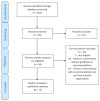Systematic Review of Health Organization Guidelines Following the AMSSM 2019 Youth Early Sport Specialization Summit
- PMID: 34668459
- PMCID: PMC8669928
- DOI: 10.1177/19417381211051371
Systematic Review of Health Organization Guidelines Following the AMSSM 2019 Youth Early Sport Specialization Summit
Abstract
Context: Youth sport specialization may place young athletes at increased risk for negative impacts to their physical and/or psychological health. In response to these health concerns, several health organizations have created guidelines and position statements to guide parents and practitioners toward best practices for management of the young athlete.
Objective: To systematically review and synthesize current organizations' recommendations and guidelines regarding youth sport specialization.
Data sources: English-language articles from January 1, 2000, to December 31, 2018, in the NCBI Pubmed, Embase, Cochrane, CINAHL, and SPORTDiscus databases.
Study selection: Articles that reported on recommendations or interventions by health organizations or health representatives of sports organizations. A total of 56 articles were assessed, with 11 meeting inclusion eligibility criteria.
Study design: Systematic review.
Level of evidence: Level 4.
Data extraction: Two investigators independently identified all recommendations within the results that fit within a 15-item framework encompassing 4 domains: Psychological Development/Approach, Physical Development/Load, Facilities and Resources, and Timing and Monitoring of Specialization.
Results: Recommendations across organizations were primarily clustered in the Physical Development/Load (43%), Facilities and Resources (48%), and Sport Specialization (55%) domains. In contrast, the Psychological Development/Approach domain had fewer recommendations (20%). The most common recommendations endorsed concepts: "Monitor athlete well-being," "Youth athletes need access to well-trained, quality coaches," "Multi-sport participation," "Limit early organized participation and/or training," and "Parents require awareness of training, coaching, and best practices." The level of evidence provided to support a given recommendation varied significantly. The level of detail and the consistency of terms used throughout the results were typically low. Recommendations were frequently made without reference to potential outcome measures or specific strategies that could be used for practical implementation in the community.
Conclusion: There was broad representation of different aspects of specialization but limited consistency between health organization guidelines. Adopting a framework for recommendations as used in this review could assist organizations in structuring future recommendations that are specific, measurable, and framed in a manner that will promote action in the youth sport community.
Keywords: athlete development; recommendations; sport specialization.
Conflict of interest statement
The following authors declared potential conflicts of interest: G.D.M. received grants from the National Institutes of Health, has patents pending for Augmented and Virtual Reality for Sport Performance and Injury Prevention Application, and has received royalties from Human Kinetic and Wolters Kowler. J.S.B. has received hospitality fees from AMSSM CRN and has received royalties from UpToDate. J.P.D. has received consultancy fees from NBA. A.I.B. is a paid consultant for American Board of Family Medicine and has received payments from American Academy of Family Physicians and hospitality fees from American Medical Society for Sports Medicine.
Figures
References
-
- Bergeron MF, Mountjoy M, Armstrong N, et al.. International Olympic Committee consensus statement on youth athletic development. Br J Sports Med. 2015;49:843-851. - PubMed
-
- Brenner JS. Overuse injuries, overtraining, and burnout in child and adolescent athletes. Pediatrics. 2007;119:1242-1245. - PubMed
-
- Brenner JS. Sports specialization and intensive training in young athletes. Pediatrics. 2016;138:e20162148. - PubMed
-
- Côté J, Lidor R, Hackfort D. ISSP position stand. To sample or to specialize? Seven postulates about youth sport activities that lead to continued participation and elite performance. Int J Sport Exerc Psychol. 2009;7:7-17.
-
- DiFiori JP, Benjamin HJ, Brenner JS, et al.. Overuse injuries and burnout in youth sports: a position statement from the American Medical Society for Sports Medicine. Br J Sports Med. 2014;48:287-288. - PubMed
Publication types
MeSH terms
LinkOut - more resources
Full Text Sources
Medical
Research Materials


